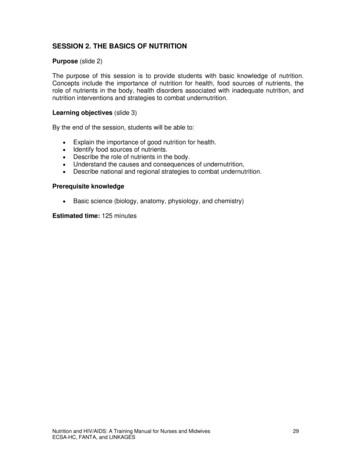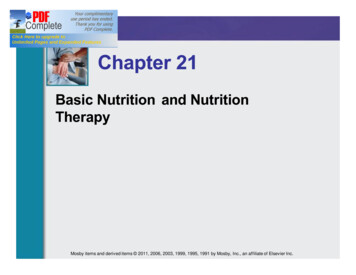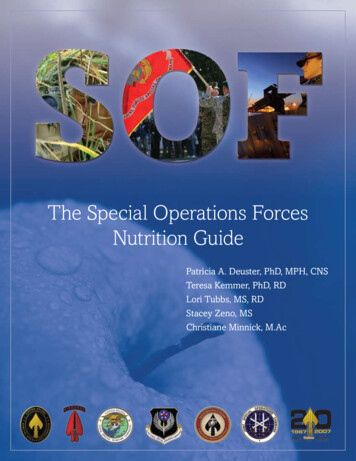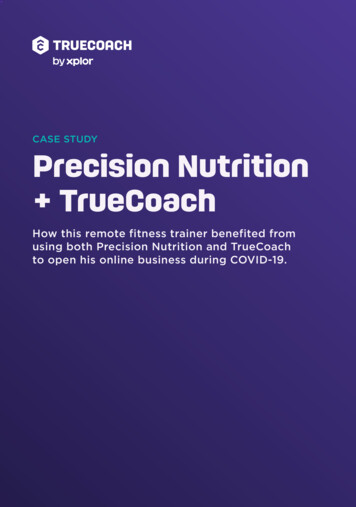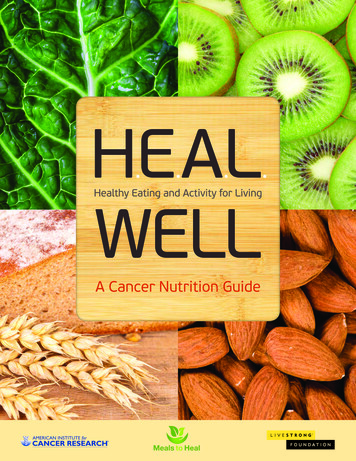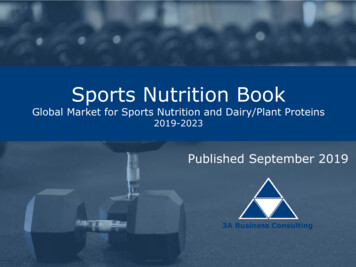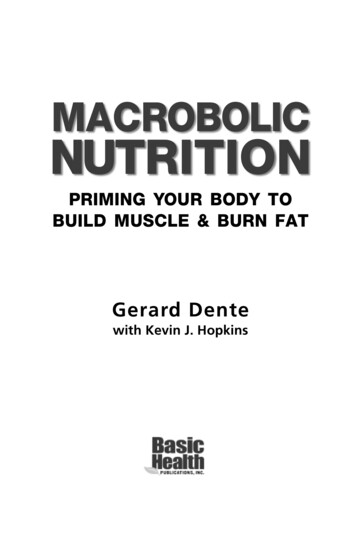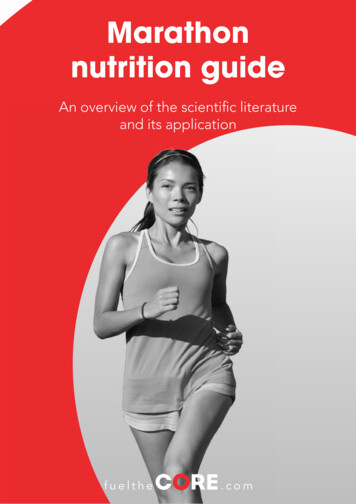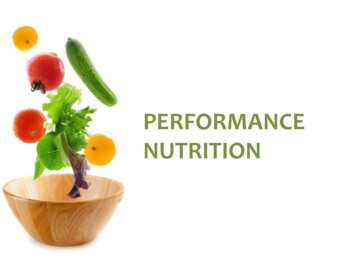
Transcription
PERFORMANCENUTRITION
WHAT YOU EAT NBODYCOMPRecoveryMENTALFOCUS
THE SHAPE OF YOUR BODY IS40%50%NUTRITIONYOURWORKOUT10 %GENETICS
THREE KEYS TO HEALTHFUL EATING MODERATION:– Nothing is off limits!– Just make wiser choices 90 % of the time BALANCE and VARIETY: Must have variety of different foods Minimum of 10 different types of foods per day
Tips to Achieving Balance Consume 3 different food groups at each meal Be sure to get both Carbohydrate and Proteinwith meals and snacks Make a colorful plate Consume foods from each food group every day DON’T miss out on important nutrients
Calories (1)A gram of carbohydrate or protein provides4 calories of energy A gram of fat provides 9 calories A gram of alcohol provides 7 calories, but isnot an essential nutrient
Calories (2) At least 60% of the diet should be in the form ofcarbohydrates; a minimum of 45% of these should becomplex carbohydrates No more than 15-20% of calories should come from fat Approximately 20% should come from protein Daily energy Recommendations (normally active person):– Male total calories*Female total calories*– 16-20 yrs.2500-290016-20 yrs.2100-2300– 23-502300-270023-502000-2200 *If you do intense training or are very active, the above estimates may need to be increased
BALANCING ENERGY NEEDSCarbohydratesProteinFatAlcoholRMRThermic effect offoodActivityEnergy IN Energy OUT (weight maintenance)Energy IN Energy OUT (weight gain)Energy IN Energy OUT (weight loss)
Rule #1 Eat a Rainbow Often Eating a variety of fruits and vegetables in a multitude of colors willhelp to ensure that you are getting the variety of nutrients that youneed. Go for color. Check you are eating a variety of colorful fruit andvegetables – think yellow, red, green and orange. Best fruits based on their total anti-oxidant per size, blueberries,blackberries,, raspberries, strawberries, granny smith apples, sweetcherries, and black plums. Best vegetables stewed tomatoes, dark leafy greens, anything that is rich inyellow, orange, an red color.
INCLUDE – Include Top PerformanceFoods From All Food Groups
Get a Good BalanceConsume foods from different food groups to meetyour energy and nutrient needsGrains (especially whole grains)– Primarily carbohydrate, some protein and fat– B-Vitamins, antioxidants, ironFruits (look for color)– Primarily carbohydrate– AntioxidantsVegetables (look for color)– Primarily carbohydrate, some protein– AntioxidantsDairy (aim for low-fat)– Carbohydrate and protein, fat amount varies– Calcium, Vitamin DMeat/Beans (think lean)– Primarily protein, some fat and carbohydrate (varies)– Iron, Zinc
Eggs Lean Meats Low-fat Cheese Low -fat Milk (dairyproducts) Yogurt Nuts Beans Peanut butter Meat alternatives (soyproducts)FAT Whole grain breads Potatoes Pasta Brown rice Fruits Cereal Oats Beans Some vegetables (corn,carrots, peas)PROTEINCARBOHYDRATESINCLUDE – Include PerformanceFoods From All Food Groups Include Good Fats In: Nuts Oils (olive oil, canolaoil) Peanut butter Seeds Fish Avocado Limit: Fast food, somerestaurant food Fried food Condiments andtoppings high in fat
RULE #2 COME BACK TO EARTH–Choose the least processed forms of foods,specifically carbohydrates, when building the majorityof your meals–An easy way to do this on the carbohydrate side ofthings look at the label and amount of fiber it has. If itdoes not have at least 3 gram of fiber, put it back andfind something that does.
Carbohydrates The main source of immediate energy for the body.Carbohydrates are the primary source when you’ re exercising hard.Carbohydrates are sugars and starches from plants TWO TYPES OF CARBOHYDRATES Simple carbohydrates, or Simple sugars–– E.G. Fruit Juice ,Sweetened Beverages, Soda, Candy, SyrupShould have these in ModerationComplex carbohydrates, or starches–Complex (starches) E.G. Cereal, Bread products, rice, pasta, beans, fruit, vegetables.–Whole grain, high-fiber starches are the preferred source of carbohydrates–Most nutritional value–45-55 % of your carbohydrates should be from complex carb–Starches help the body maintain normal blood-sugar om/video/2424-healthy-food-choices-breads/
Carbohydrate NeedsRecommendation(g/kg/day)Calculated rangefor 65kg (143 lb)Averagepopulation3-5 g/kg(1.4-2.3 g/lb)260-325 grams(1040-1300 calories)Strength Athlete5-7 g/kg(2.3-3.2 g/lb)325-455 grams(1300-1820 calories)Endurance Athlete7-10 g/kg(3.2-4.5 g/lb)455-650 grams(1820-2600 calories)Ultra-enduranceAthlete 10-12 g/kg( 4.5-5.5 g/lb) 650 gramsAt least 2600 calories
FoodCarbohydrates In FoodAmountCarbs (g)1 smallSmall (2-in.)1 slice11 small13-to 4-inch3 c. popped2 squares51 large1 cup1 cup½ package5-6 inch311515252115351510105040452515Breakfast CerealsRaisin BranGranola, low-fatOatmeal, instant¾ cup½ cup1 packet3045301 cup8 ounces5012DairyFruit YogurtMilk, 2%AmountCarbs (g)1 medium1 medium1 medium1/3 to ½ cup201525601 cup½ cup1 medium½ cup2 cups raw30-45151055-108 ounces8 ounces1 shake25-301430-501 tablespoon151 cup1 bar4440-60FruitGrains, Pasta, StarchesBagelBiscuitBread, slicedEnglish MuffinPitaWafflePancakePopcornGraham CrackersSaltinesBaked PotatoSpaghetti, cookedRice, cookedRamen NoodlesTortilla, corn or flourFoodAppleOrangeBananaFruit, driedVegetableBeans, Peas, LentilsCornCarrotGreen Beans, BroccoliSalad GreensBeveragesFruit JuiceGatoradeGatorade shakesCondiments, DessertsHoney, Jam, MapleSyrupFrozen YogurtSport Bar
Rule #3 The Less Legs the Better Typically the less legs the animal has before you actuallyconsume it, the better source. Best source fish, turkey, and chicken rank high You need to be more selective with dairy, red meat, andpork products. Low-fat dairy, lean cuts of pork and beef,and grass fed legged animals are best.
Protein (1) Essential for building and repairing muscles, redblood cells, hair, and other tissues. Approximately 20% of calories should come fromprotein Proteins generally supply little of the energy thebody uses, except during prolonged exercise. Proteins are composed of amino acids
Protein (2) Complete proteins (usually found in meat and dairy foods)– contain all essential amino acids– choices-meat/ Incomplete proteinsfoods)do not contain amino acids in proportions needed (plant Excess protein is stored as fat High protein intake strains the kidneys Surplus protein will not increase strength or muscle size A high intake of protein, also requires a high intake of water
Athlete’s Protein NeedsRecommendation(g/kg/day)Calculated rangefor 65kg (143 lb)Averagepopulation.8 g/kg(0.36 g/lb)52 grams(208 calories)Strength Athlete1.6-1.7 g/kg(0.73 – 0.77 g/lb)104-110grams(416-440 calories)Endurance Athlete1.2-1.4 g/kg(0.55 – 0.64 g/lb)78-91 grams(312-364 calories)Simple calculation for quick assessment:Weight in pounds x .6 or .7Estimated Needs: 86-100 gr Protein(I will go up to 1 gram Protein/pound body weight)
Protein In FoodFoodServing SizeProtein (g)Meat, Fish, PoultryEgg (2 egg whites)Tuna (canned)Beans, Legumes, split peasPeanut butterAlmonds (most nuts)Tofu (firm)Milk or yogurtCottage cheeseAmerican cheeseHard cheeseRice, noodles, pastaBreadCold cerealPeas, corn, carrots (most vegetables)Fruits4 ounces cooked1 large1 can (6 oz)½ cup2 tablespoons¼ cup4 ounces1 cup (8 oz)½ cup1 slice (.75 oz)1 oz½ cup1 slice1 cup½ cup1 piece3074078710814672222 1
Rule #4 Eat Fats That GiveSomething Back The best types of fats to include are raw nuts, seeds, oliveoil, and fat fish The forgotten fats in the US are the essential fatty acids,specifically omega-3 fatty acids Consume fish high in omega 3 two to three times per week
Fat (1) A source of stored energy (calories) that we burn primarilyduring low-level activity. Saturated Fats (Animal fats)– Contribute to heart disease and some cancers– E.G: butter, lard, fat in meats Unsaturated Fats (Vegetable Fats)– Less Harmful– E.G: corn oil, olive oil, peanut oil
Athlete’s Fat Needs Aim for 20-30% of total calories comingfrom fat Remember 1 gram of fat 9 calories Based on 2700 calories2700 x .20 540 cal/9 60 grams2700 x .30 810 cal/9 90 grams Estimated Needs: 60-90 grams of fat
Rule #5 Three for Three Companioning the three main nutrients (carbs, protein,fat) every three hours will keep you fueled Eating consistently maintains energy levels (bloodglucose), keeps the body in a fed state and prevents moodswings and binging
SCHEDULE – Schedule a Fueling PlanTo Maximize TrainingFocus on these Key Points to Timing It Right Eat frequently to maintain a full tank(4-8 times per day) Constant fuel, every 2-4 hours Eat Breakfast DAILY 3-4 meals/day with snacks Special focus on fueling and refuelingfor activity
Scheduled Eating Examples6am-7am Snack/pre-workout8am-9am breakfast7am-9am workout10:30am snack9ampost-workout ut12-1pmlunch3-5pmpractice3pmsnack (possible er9pmsnack9pmsnack
Rule # 6 Eat Breakfast Most important meal of the day Sample meal:– Whole wheat bagel or toast or English Muffin– 2 scrambled eggs or egg whites– 1 piece of fruit– Milk or yogurt
Rule #7 Don’t waste your workout In order to optimize the benefits of a training session andjumpstart recovery for maximal gains, it is critical toconsume a post workout recovery meal that blends bothcarbohydrate and protein within 45 minutes after training l-foryour-workout.html
Planning for Practice Never start a workout with an empty tank Remember, you should be eating every 3-4hrs. Pre-workout meal 2-4 hrs ahead of time High carbohydrate, moderate protein, low, fat Pre-workout snack Within 1-2 hrs Mainly carbohydrate, some protein and fat Determine what you can tolerate Fruit and yogurt, Gatorade and granola bar, cerealwith skim milk l-for-your-workout.html
Fueling During Training Especially important for activity lastinggreater than 60-90 minutes 100-250 calories (30-60 grams CHO) everyhour––––Sports drinksSports barsGranola barsFruit (can be dried or fresh) Hydrate to minimize water loss(Typically 4-8 oz every 15 minutes)
RECOVERY -- Recovery NutritionFor Daily TrainingYou’re body will not run on an empty gas tank,you must replenish and refill the gas regularly!!1.Recovery begins with proper fueling prior totraining2. Recovery continues with maintaining fuel levelsduring activity3. Recovery’s claim to fame time is within 30 minutesafter a workout4. Recovery should continue as you prepare for thenext trainingBack to back training requires heavy focuson recovery nutrition
Ideal Recovery Foods/Snacks Chocolate milk Yogurt and fruit Trail mix (nuts, seeds, dried fruit, cereal,etc) String cheese and wheat crackers Sports bar/shake Peanut butter and jelly sandwich Cereal with skim milk*Include at least 2 cups water/Gatorade*
RULE # 8 HYDRATE – Hydrate To Keep TheBody Cool and Running Efficiently Focus on hydration ALL DAY long, notonly when training Significant decreases in performanceare seen with 2% body water loss for a 160 pound athlete, this would be a 3.2 #loss, weighing 156-157 or less after workout
Daily Fluids Intake Sedentary person needs weight in pounds x.50 Active person needs weight in pounds x.67 Example: 200 lb male» 200 x .67 134 oz» You can get from drinks, soups, eating fruit andvegetables» Don’t count liquid that contain caffeine or alcohol
FLUIDS REPLACEMENT FOR PHYSICALACTIVITY *Drink plenty of water even if you do not feel thirsty. *Drink 16-20 oz cups of plain, cool water 15 minutes before physical activity *Drink 7- oz cup of water every 10-15 minutes during physical activity *Drink 2 cups of water after physical activity for every pound lost duringactivity *Sports drinks have a high amount of salt and sugar, these twoingredients can negatively affect performance–physicalDuring times of intense activity, extreme temperatures, and long duration a carbohydrate electrolyte beverageis optimal*Urine color is an indication of hydration, if it’s yellow you are probably dehydrated.
Rule # 9Supplement Wisely Supplements should “compliment” the diet and amentality of food first supplement second should beemployed Basic supplementation protocol
Vitamins and Minerals Won’t provide energy, but necessary forenergy production, bone health, immunesystem and muscle function––––B-VitaminsIronCalcium and Vitamin DAntioxidants Vitamins C, E, and A Iron, Zinc, Copper and Selenium– Electrolytes (Sodium and Potassium)
Rule # 10 Keep Record Track nutrition intake along with training Identify what works and what doesn’t Individualize nutrition routines
Dietary SupplementsDefinition: “a vitamin, mineral, herb, botanical, amino acid, metabolite,constituent, extract or a combination of any of these ingredients.” Why they are used– Help meet nutritionalgoals Vitamins/minerals Bars/shakes– Enhanced Performance Direct and/or psychological– Examples: creatine,caffeine, hormones,amino acids, anabolicsteroids, HGH, etc etyContaminationLegal/PermissableExpenseSide effectsDistraction from realperformance enhancingpractices
Legality Safety Efficacy On the shelf or on the internet doesn’t make it safe!(US Dietary Supplement Health and Education Act)– DO NOT need to be proven effective– DO NOT need to be proven safe– FDA must prove it to be harmful before it can be regulated False Claims:– Marketing may only include part of the story– Labeling not regulated Medical Commission of the IOC (2002) Of 634 supplements analyzed, 94 (15%) contained substances thatcould lead to a positive doping testDrug Free Sport Resource: www.drugfreesport.com/recPasscode for Division 1: ncaa1
Be Aware -- Top 10 Freshman Mistakes1.2.3.4.5.6.7.8.9.10.Skipping MealsTrying Popular Diets/ Nutrition FadsIrresponsibly Using Nutrition SupplementsMisusing Sports FoodsMaking Poor Choices at All-You-Can-EatDining HallsMaking Poor Drinking DecisionsDoing a Poor Job HydratingThe Jeans Phenomenon not accepting bodychangingPaying Too Much Attention to the ScaleLate Night Junk Food
Related Sports Nutrition Links Nutrition Core Daily Core Performance s-and-sports-nutrition http://orthoinfo.aaos.org/topic.cfm?topic a00370 http://urbanext.illinois.edu/hsnut/ uide
6am-7am Snack/pre-workout. 8am-9am breakfast 7am-9am workout. 10:30am snack 9am post-workout recovery. 1pm lunch 10am breakfast. 2:30pm snack/pre-workout 12-1pm lunch. 3-5pm practice 3pm snack (possible pre-workout) 5pm post-workout recovery 6pm dinner


